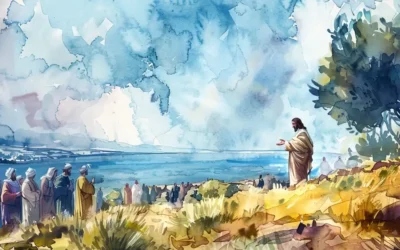The Preaching of John the Baptist
1 The beginning of the gospel of Jesus Christ, the Son of God.
2 As it is written in Isaiah the prophet: “BEHOLD, I SEND MY MESSENGER AHEAD OF YOU, WHO WILL PREPARE YOUR WAY;
3 THE VOICE OF ONE CRYING IN THE WILDERNESS, ‘MAKE READY THE WAY OF THE LORD, MAKE HIS PATHS STRAIGHT.’ “
4 John the Baptist appeared in the wilderness preaching a baptism of repentance for the forgiveness of sins.
5 And all the country of Judea was going out to him, and all the people of Jerusalem; and they were being baptized by him in the Jordan River, confessing their sins.
6 John was clothed with camel’s hair and wore a leather belt around his waist, and his diet was locusts and wild honey.
7 And he was preaching, and saying, “After me One is coming who is mightier than I, and I am not fit to stoop down and untie the thong of His sandals.
8 “I baptized you with water; but He will baptize you with the Holy Spirit.” The Baptism of Jesus
9 In those days Jesus came from Nazareth in Galilee and was baptized by John in the Jordan.
10 Immediately coming up out of the water, He saw the heavens opening, and the Spirit like a dove descending upon Him;
11 and a voice came out of the heavens: “You are My beloved Son, in You I am well-pleased.”
12 Immediately the Spirit impelled Him to go out into the wilderness.
13 And He was in the wilderness forty days being tempted by Satan; and He was with the wild beasts, and the angels were ministering to Him.
Genre:
The Gospel of Mark is a Greco-Roman biography, written in the first century AD. It is a narrative account of the life, ministry, death, and resurrection of Jesus Christ, emphasizing his actions more than his teachings.
Textual Criticism: Mark 1:1-13 is generally well-preserved in the manuscript tradition. However, there are some variations in wording and order among ancient manuscripts, though these do not significantly impact the overall meaning of the passage.
Greek and Hebrew Grammar:
- The Greek in Mark 1:1 is relatively straightforward, with “archē” (beginning) introducing the concept of the gospel of Jesus Christ.
- In verse 2, the phrase “hōs gegraptai en tō Isaiā tō prophētē” (as it is written in Isaiah the Prophet) introduces a quotation from the Old Testament, highlighting the fulfillment of prophecy.
- Verse 3 contains a quote from Isaiah 40:3, with the phrase “Hē paragōn hōdos Kyriou” (The voice of one crying in the wilderness) translating the Hebrew “Qōl qôrê bâmidbār,” emphasizing John the Baptist’s role as a forerunner.
- The imperfect tense in verse 4 (“ebaptizen”) emphasizes the ongoing nature of John’s baptism.
- The Greek phrase “kai enautōi haIoudaia pās kai hoi Ierousalēm pantes” in verse 5 indicates the widespread response to John’s message, with all the country of Judea and all Jerusalem going out to him.
- In verse 6, the description of John’s clothing and diet emphasizes his ascetic lifestyle, echoing the clothing of the prophet Elijah.
- The phrase “prepares the way” in verse 3 and “make his paths straight” in verse 3 are both translations of the Greek verb “hetoimasate,” which carries the idea of preparing or making ready.
- The use of the aorist tense in verse 9 (“ēlthen”) indicates the suddenness of Jesus’ arrival from Nazareth.
- The verb “suntarássō” in verse 10 (“torn open”) is a vivid term, suggesting a violent or sudden action in the heavens.
- The phrase “enautōi haIordanē Iēsous” in verse 9 highlights the location of Jesus’ baptism in the Jordan River.
Historical Context: Mark’s Gospel was likely written during a time of persecution of Christians in Rome, possibly during the reign of Nero in the 60s AD. The reference to John the Baptist and his ministry reflects a historical figure known for his preaching and baptismal practices in first-century Judea. The baptism of Jesus by John is a significant event in the early Christian movement, symbolizing Jesus’ identification with humanity and his mission to bring about the kingdom of God.
Literary Context: Mark begins his Gospel with the ministry of John the Baptist, portraying him as the prophesied messenger preparing the way for the Lord. The baptism of Jesus marks the beginning of Jesus’ public ministry and is followed by his temptation in the wilderness, where Satan tests him. This sets the stage for Jesus’ ministry of preaching, healing, and demonstrating his authority over sin and sickness, leading ultimately to his crucifixion and resurrection.
In summary, Mark 1:1-13 introduces Mark’s Gospel, establishing Jesus’ identity as the Son of God and setting the stage for his ministry on earth. The passage highlights vital themes of preparation, baptism, and the proclamation of the gospel, setting the tone for the rest of the narrative.
Commentary
Verse 1: “The beginning of the gospel of Jesus Christ, the Son of God.”
This opening verse serves as the title and thesis statement of the Gospel of Mark. It introduces the central theme of the entire book: the good news about Jesus Christ, who is identified as the Son of God. This declaration sets the stage for the rest of the Gospel, which will focus on Jesus’ identity, teachings, miracles, death, and resurrection.
Verses 2-8: “As it is written in Isaiah the prophet: ‘Behold, I send My messenger before Your face, Who will prepare Your way; The voice of one crying in the wilderness: ‘Prepare the way of the Lord, Make His paths straight.'”
John came baptizing in the wilderness and preaching a baptism of repentance for the forgiveness of sins. All the country of Judea and all those from Jerusalem went out to him and were baptized by him in the Jordan River, confessing their sins. Now John was clothed with camel’s hair and wore a leather belt around his waist, and his diet was locusts and wild honey. And he preached, saying, “There comes One after me who is mightier than I, whose sandal strap I am not worthy to stoop down and loose. I indeed baptized you with water, but He will baptize you with the Holy Spirit.”
These verses introduce John the Baptist as the fulfillment of Old Testament prophecy, specifically citing Isaiah 40:3 and Malachi 3:1. John’s role is to prepare the way for the coming of the Lord (Jesus) by preaching a message of repentance and baptizing people as a symbol of their cleansing from sin. John’s attire and lifestyle reflect his prophetic role, and he humbly acknowledges Jesus’ superiority and the spiritual baptism that Jesus will bring.
Verses 9-13: “It came to pass in those days that Jesus came from Nazareth of Galilee, and was baptized by John in the Jordan. And immediately, coming up from the water, He saw the heavens parting and the Spirit descending upon Him like a dove. Then a voice came from heaven, ‘You are My beloved Son, in whom I am well pleased.’ Immediately the Spirit drove Him into the wilderness. And He was there in the wilderness forty days, tempted by Satan, and was with the wild beasts; and the angels ministered to Him.”
These verses describe the baptism of Jesus by John and the subsequent events. Jesus’ baptism marks the beginning of his public ministry. It is accompanied by the visible descent of the Holy Spirit and the audible voice of God, affirming Jesus as His Son. The Spirit then leads Jesus into the wilderness, where he undergoes a period of testing and temptation by Satan. Despite these challenges, Jesus remains faithful and is cared for by angels, highlighting his divine nature and mission.
Overall, Mark 1:1-13 sets the stage for the Gospel of Mark by establishing Jesus’ identity, mission, and authority. It introduces vital themes of repentance, baptism, the Holy Spirit, and the coming kingdom of God, which will be further developed throughout the rest of the Gospel.


